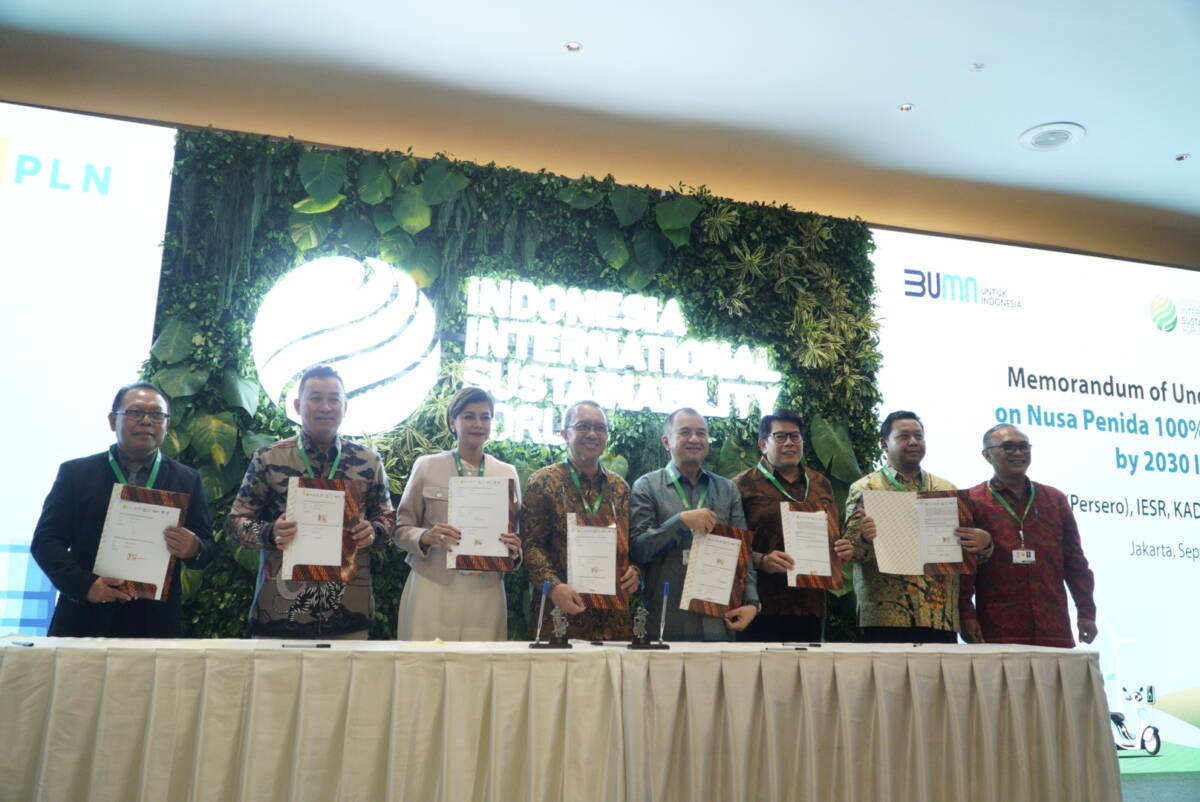Jakarta, September 5, 2024 – The Institute for Essential Services Reform (IESR) and the Bali Provincial Government have committed to supporting the Bali Net-Zero Emission 2045 initiative in 2023. In 2024, they have started the Nusa Penida 100 percent renewable energy by 2030 initiative by finalizing an integrated roadmap to achieve the target.
Synergy and support from various parties, not only the government but also PLN and the private sector, are important factors to encourage the implementation of the Nusa Penida 100 percent renewable energy initiative. To that end, IESR together with a number of strategic partners that include key stakeholders in Indonesia’s energy sector, namely PT Perusahaan Listrik Negara (Persero), the Indonesian Chamber of Commerce and Industry (Kadin), the Indonesian Renewable Energy Society (METI), the Indonesian Solar Energy Association (AESI), the Indonesian Wind Energy Association (AEAI), and PT Bali Kerthi Development Fund Ventura, signed a Memorandum of Understanding (MoU) to realize Nusa Penida as a 100 percent renewable energy island in the midst of the Indonesia International Sustainability Forum (ISF) 2024 event in Jakarta.
The Executive Director of IESR, Fabby Tumiwa, explained that the signing of this MoU marks the commitment of key renewable energy stakeholders in Indonesia to encourage investment and mobilize resource support for the utilization of 100 percent renewable energy to become Nusa Penida, the iconic island of renewable energy. According to him, the utilization of abundant renewable energy in the region will increase the attractiveness of Nusa Penida as a major tourist destination, which has an impact on improving the welfare of local communities and preserving Bali’s natural environment.
“Within the next six years the electricity system in Nusa Penida must start adding renewable energy capacity to meet the increasing demand for electricity before finally replacing the Diesel Power Plant (PLTD) completely with renewable energy. For this reason, before 2030 ground mounted solar power plants, rooftop solar power plants, wind power plants, biomass power plants, energy storage systems, and grid strengthening must be built; with investment needs reaching USD 100 million. The funding needs and scale of renewable energy development on Nusa Penida Island can only happen if there is a partnership between PLN, PT Indonesia Power, and business actors who invest in renewable energy plants,” Fabby said.
Based on analysis by IESR and Udayana University’s Center of Excellence Community Based Renewable Energy (CORE), the potential for renewable energy in Nusa Penida reaches more than 3,219 megawatts (MW), consisting of 3,200 MW of ground-mounted solar PV, 11 MW of rooftop solar PV, 8 MW of biomass, not including the potential for wind energy, ocean currents, and biodiesel. In the Nusa Penida 100% Renewable Energy Roadmap, there is a recommendation for three phases of implementation of this initiative with the construction of solar power plants and the reduction of PLTD operations, strengthening the network and system management, and the construction of biomass power plants and other renewable energy coupled with energy storage systems to fully replace PLTD.
Dewanto, Vice President of Various Renewable Energy, PT PLN emphasized that his party continues to carry out government programs in achieving NZE, as well as significantly reducing the use of fossil energy. This effort is also carried out in areas where the source of electricity still comes from PLTD.
Solihin J Kalla, Vice President for Energy and Mineral Resources, KADIN Indonesia, said that his party as a forum for business people in Indonesia wants to encourage energy transition as one of the country’s investment prima donnas. For this reason, the implementation of the Nusa Penida road map to achieve the target of 100 percent renewable energy by 2030 can be one of the collaborative and inclusive energy transition models.
Meanwhile, Andhika Prastawa, Chairman II of METI stated that his party is committed to continuing to support the acceleration of clean energy in Bali by maintaining the stability of PLTS Hybrid Nusa Penida as a major pillar of achieving Bali NZE 2045.
In line, Mada Ayu Hapsari, Chairperson of the Indonesian Solar Energy Association (AESI) mentioned the benefits of utilizing PLTS in Nusa Penida. According to her, Solar Power Plant (PLTS) will be a reliable generator, with advantages in the form of ease of application and maintenance.
Agung Hernawan, Chairman of AEAI stated that the potential for wind energy development in Nusa Penida is promising, although not yet fully optimized.
“We play a key role in supporting this development, liaising between the government and energy developers, assisting in providing information related to regulations, as well as promoting and advocating for renewable energy policies. We also actively encourage the creation of a better investment climate, and collaborate with the private sector and government to accelerate the procurement of wind power projects in various regions, including Nusa Penida,” Agung said.
President Director of PT Bali Kerthi Development Fund Ventura (BDF), I Made Gunawirawan emphasized that the agency he currently leads was born at the initiation of the Minister of Bappenas and the Governor of Bali to support the Bali Kerthi Economic Transformation, one of whose pillars encourages the development of clean energy to create Green Bali.
“In an effort to support the implementation of the Nusa Penida 100% Renewable Energy road map in 2030, we play a role as a financial intermediary. This support can be in the form of financing for the procurement of solar power plants for the Nusa Penida community,” said I Made Gunawiraman.
The Bali NZE 2045 initiative is also supported by Indonesian philanthropy organization ViriyaENB and the Bali Zero Net Emission Coalition consisting of WRI Indonesia, Nexus Indonesia, CAST Foundation, and IESR.

